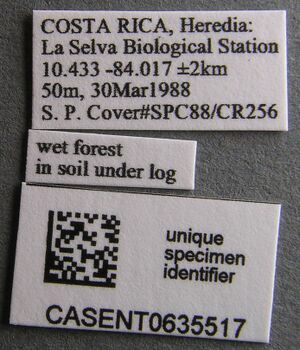Pheidole rectitrudis
| Pheidole rectitrudis | |
|---|---|

| |
| Scientific classification | |
| Kingdom: | Animalia |
| Phylum: | Arthropoda |
| Class: | Insecta |
| Order: | Hymenoptera |
| Family: | Formicidae |
| Subfamily: | Myrmicinae |
| Tribe: | Attini |
| Genus: | Pheidole |
| Species: | P. rectitrudis |
| Binomial name | |
| Pheidole rectitrudis Wilson, 2003 | |
Evidently uncommon. The type colony was collected by Stefan Cover in the soil of lowland rainforest beneath a log. The Mexican colonies were found in cloud forest. (Wilson 2003)
Identification
See the description in the nomenclature section.
Keys including this Species
Distribution
From Wilson (2003): Known from the type locality and from Peñas Blancas Valley, Costa Rica (Longino 1997); and near San Andres Tuxtla (1500 m) and Orizaba (1600 m), Mexico, col. P. S. Ward.
Latitudinal Distribution Pattern
Latitudinal Range: 17.5155524° to 9.4851644°.
| North Temperate |
North Subtropical |
Tropical | South Subtropical |
South Temperate |
- Source: AntMaps
Distribution based on Regional Taxon Lists
Neotropical Region: Costa Rica (type locality), Guatemala, Honduras, Mexico, Nicaragua, Panama.
Distribution based on AntMaps
Distribution based on AntWeb specimens
Check data from AntWeb
Countries Occupied
| Number of countries occupied by this species based on AntWiki Regional Taxon Lists. In general, fewer countries occupied indicates a narrower range, while more countries indicates a more widespread species. |

|
Estimated Abundance
| Relative abundance based on number of AntMaps records per species (this species within the purple bar). Fewer records (to the left) indicates a less abundant/encountered species while more records (to the right) indicates more abundant/encountered species. |

|
Biology
Castes
Worker
Minor
Images from AntWeb
  
| |
| Worker. Specimen code casent0635517. Photographer J. Longino, uploaded by University of Utah. | Owned by JTLC. |
Nomenclature
The following information is derived from Barry Bolton's Online Catalogue of the Ants of the World.
- rectitrudis. Pheidole rectitrudis Wilson, 2003: 496, figs. (s.w.) COSTA RICA.
Unless otherwise noted the text for the remainder of this section is reported from the publication that includes the original description.
Description
DIAGNOSIS Similar to Pheidole bilimeki, Pheidole floridana, Pheidole hazenae, Pheidole rectiluma, Pheidole rectisentis, Pheidole rectispina, Pheidole sospes and Pheidole stomachosa, differing as follows.
Major: propodeal spines robust, half as long as propodeal basal face, vertical to propodeum; frontal lobes, vertex, and dorsal midline strip to occiput carinulate and rugulose; occipital lobes smooth with scattered foveae; sides of head rugoreticulate; humeri longitudinally rugulose, and promesonotal dorsum transversely carinulate; postpetiole from above conulate.
Minor: all of dorsal surface of head from eye level to occiput rugoreticulate, as well as all of promesonotal dorsum; propodeal spines long, robust, and vertical to propodeal basal face.
MEASUREMENTS (mm) Holotype major: HW 0.90, HL 0.98, SL 0.48, EL 0.12, PW 0.48. Paratype minor: HW 0.50, HL 0.54, SL 0.44, EL 0.08, PW 0.32.
COLOR Major: body, scape, and mandibles dark, almost blackish brown; legs and funiculus medium brown.
Minor: head, mesosoma, petiole, and appendages medium brown; postpetiole and gaster dark brown.
Figure. Upper: holotype, major. Lower: paratype, minor. Scale bars = 1 mm.
Type Material
COSTA RICA: La Selva Biological Station, near Puerto Viejo, col. Stefan Cover. Museum of Comparative Zoology
Etymology
L rectitrudis, erect pike or pointed pole, alluding to propodeal spines.
References
- Wilson, E. O. 2003. Pheidole in the New World: A dominant, hyperdiverse ant genus. Harvard University Press, Cambridge, MA. (page 496, fig. major, minor described)
References based on Global Ant Biodiversity Informatics
- Dattilo W. et al. 2019. MEXICO ANTS: incidence and abundance along the Nearctic-Neotropical interface. Ecology https://doi.org/10.1002/ecy.2944
- Fernández, F. and S. Sendoya. 2004. Lista de las hormigas neotropicales. Biota Colombiana Volume 5, Number 1.
- Longino J. T. L., and M. G. Branstetter. 2018. The truncated bell: an enigmatic but pervasive elevational diversity pattern in Middle American ants. Ecography 41: 1-12.
- Longino J. T., and R. K. Colwell. 2011. Density compensation, species composition, and richness of ants on a neotropical elevational gradient. Ecosphere 2(3): 16pp.
- Longino J. et al. ADMAC project. Accessed on March 24th 2017 at https://sites.google.com/site/admacsite/

